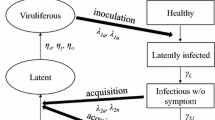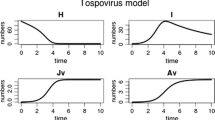Summary
Seasonal changes in the densities of eggs and of 1st instar nymphs ofN. cincticeps, a vector of the rice dwarf virus (RDV) and those in the proportion of virus-infected rice hills were examined by regular field censuses during the period of 1964–69 at two localities in Kochi, Nangoku and Ino. The proportion of virus-infected insects in the vector population was measured by the serological test. Mean fecundity of adult females ofN. cincticeps in different generations was assessed by the method proposed byHokyo andKiritani (1968) in 1966 and 1967.
Using observed variables as mentioned above, two mathematical models were built up for the system of the natural spread of infection of RDV. Submodels describing generation-to-generation changes in densities of eggs, 1st instar nymphs and leafhopper adults were involved in bothModels 1 and2. InModel 1, the proportion (P) of infected insects in the vector population was assumed to be determined directly by the amount (I v ) of infected rice plants in the field. InModel 2, instead of relatingP directly toI v ,P was related to the acquisition rate (W) of RDV by the insects and to the effect of RDV (αr) on fecundity and survival of infected insects. Then,W was related toI v .
The estimates ofP by these models fitted well to the observed values for 1st to 3rd generations but a great deviation was noted in 4th and 5th generations. For the percentage of infected rice hills, both models gave relatively good estimates in the early planted rice, though they gave overestimated values in the late planted rice.
Similar content being viewed by others
References
Bailey, N. T. J. (1957)The mathematical theory of epidemics. Charles Griffin and Company, London, 194 pp.
Fukushi, T. (1934) Studies on the dwarf disease of rice plant.J. Facult. Agr. Hokkaido Imp. Univ. 37: 41–164.
Fukushi, T. (1940) Further studies on the dwarf disease of rice plant.J. Facult. Agr. Hokkaido Imp. Univ. 45: 83–154.
Hara, K. (1967) Occurrence and control of rice dwarf virus (RDV) in Kagoshima Prefecture.Shokubutsu-böeki 21: 55–59. (in Japanese)
Hashizume, B. (1964) Studies on forecasting and control of the green rice leafhopper,Nephotettix cincticeps Uhler with special reference to eradication of the rice dwarf desease.Mem. Assoc. Plant Protection Kyushu, No. 2: 1–77. (In Japanese with English summary)
Hokyo, N. andK. Kiritani (1968) A method for estimating natural survival rate and mean fecundity of an adult insect population by dissecting the female reproductive organs.Res. Popul. Ecol. 9: 130–142.
Inoue, T. andF. Nakasuji (1967) Protective covering of early-sown rice-nurseries with cheese-cloths for preventing the invasion of the jassid vector,Nephotettix cincticeps, into the nurseries.Proc. Assoc. Pl. Prot. Shikoku, No. 2: 35–38. (In Japanese)
Ishii, M., S. Yasuo andT. Yamaguchi (1970) Epidemiological studies on rice dwarf disease in Kanto-Tosan district, Japan.J. Central Agric. Exp. Sta., No. 14: 1–115. (In Japanese with English summary)
Kawahara, S., K. Kiritani andT. Sasaba (1971) The selective activity of rice pest insecticides against the green rice leafhopper and spiders.Botyu-Kagaku 36: 121–128. (in Japanese with English summary)
Kiritani, K., N. Hokyo, T. Sasaba andF. Nakasuji (1970) Studies on population dynamics of the green rice leafhopper,Nephotettix cincticeps Uhler: Regulatory mechanism of the population density.Res. Popul. Ecol. 12: 137–152.
Köno, T. (1970) Epidemiology of rice stripe virus (RSV) transmitted by the small brown planthopper.Jap. J. Appl. Ent. Zool. 14: 154–156, Abstracts of the 10th symposium of the society. (In Japanese)
Kuno, E. (1968) Studies on the population dynamics of rice leafhoppers in a paddy field.Bull. Kyushu Agric. Exp. St. 14: 131–246. (In Japanese with English summary)
Kuno, E. andN. Hokyo (1970) Comparative analysis of the population dynamics of rice leafhopper,Nephotettix ci ncticeps Uhler andNilaparvata lugens Stal, with special reference to natural regulation of their numbers.Res. Popul. Ecol. 12: 154–184.
Maramorosch, K. (1968) Effects of rice pathogenic virus on their insect vector.Proc. Symp. Virus Disease of the Rice Plant at IRRI 1967: 179–203.
Nakasuji, F. (1970) Dissemination of rice dwarf virus (RDV) by the green rice leafhopper,Nephotettix cincticeps.Shokubutsu-böeki 24: 507–513. (In Japanese)
Nakasuji, F. andK. Kiritani (1970a) Ill-effects of rice dwarf virus upon its vector,Nephotettix cincticeps Uhler (Hemiptera: Deltocephalidae), and its significance for changes in relative abundance of infected individuals among vector populations.Appl. Ent. Zool. 5: 1–12.
Nakasuji, F. andK. Kiritani (1970b) Rate of feeding acquisition of rice dwarf virus (RDV) by the green rice leafhopper,Nephotettix cincticeps.Proc. Assoc. Pl. Prot. Shikoku, No. 5: 1–9. (In Japanese with English summary)
Nakasuji, F. andK. Kiritani (1971) Inter-generation changes in relative abundance of insects infected with rice dwarf virus in populations ofNephotettix cincticeps Uhler (Hemiptera: Deltocephalidae).Appl. Ent. Zool. 6: 75–83.
Nakasuji, F. andS. Nomura (1968) A study on the injury by the green rice leafhopper,Nephotettix cincticeps Uhler,Proc. Assoc. Pl. Prot. Shikoku, No. 3: 21–26. (In Japanese)
Nasu, S. (1963) Studies on some leafhoppers and planthoppers which transmit virus diseases of rice plant in Japan.Bull. Kyushu Agric. Exp. St., No. 8: 153–349. (In Japanese with English summary)
Shinkai, A. (1962) Studies on insect transmissions of rice virus disease in Japan.Bull. Nat. Inst. Agric. Sci. Ser. C, No. 14: 1–112. (In Japanese with English summary)
Watson, M. A. andM. J. R. Healy (1953) The spread of beet yellows and beet mosaic viruses in the suger-beet root crop. II. The effects of aphid numbers on disease incidence.Ann. Appl. Biol. 40: 38–59.
Author information
Authors and Affiliations
Additional information
A part of this research was supported by science research fund from the Ministry of Education.
Rights and permissions
About this article
Cite this article
Nakasuji, F., Kiritani, K. Descriptive models for the system of the natural spread of infection of rice dwarf virus (RDV) by the green rice leafhopper,Nephotettix cincticeps Uhler (Hemiptera: Deltocephalidae). Res Popul Ecol 14, 18–35 (1972). https://doi.org/10.1007/BF02511183
Issue Date:
DOI: https://doi.org/10.1007/BF02511183




